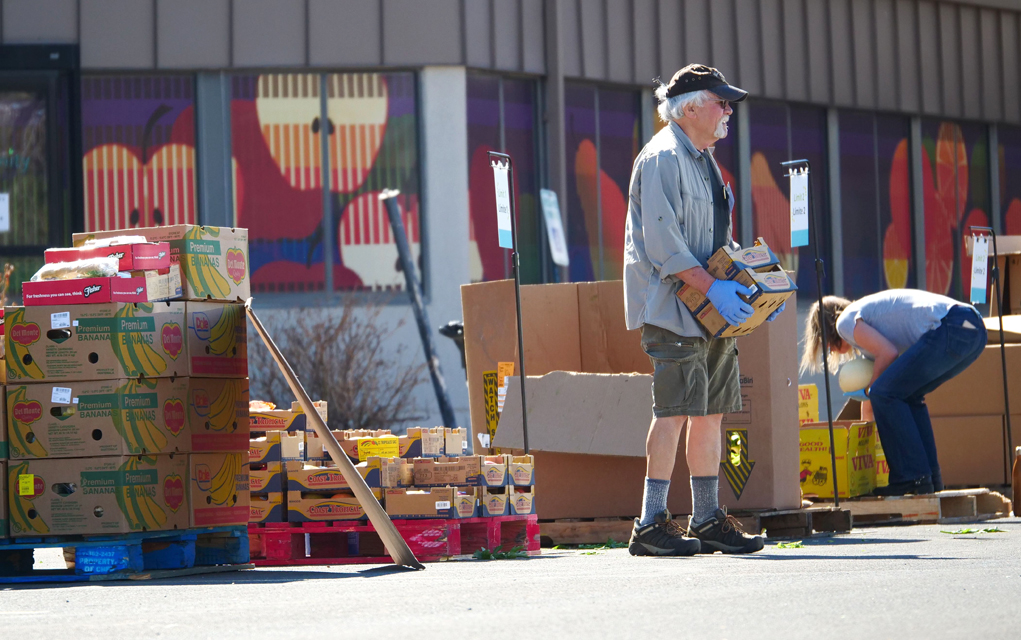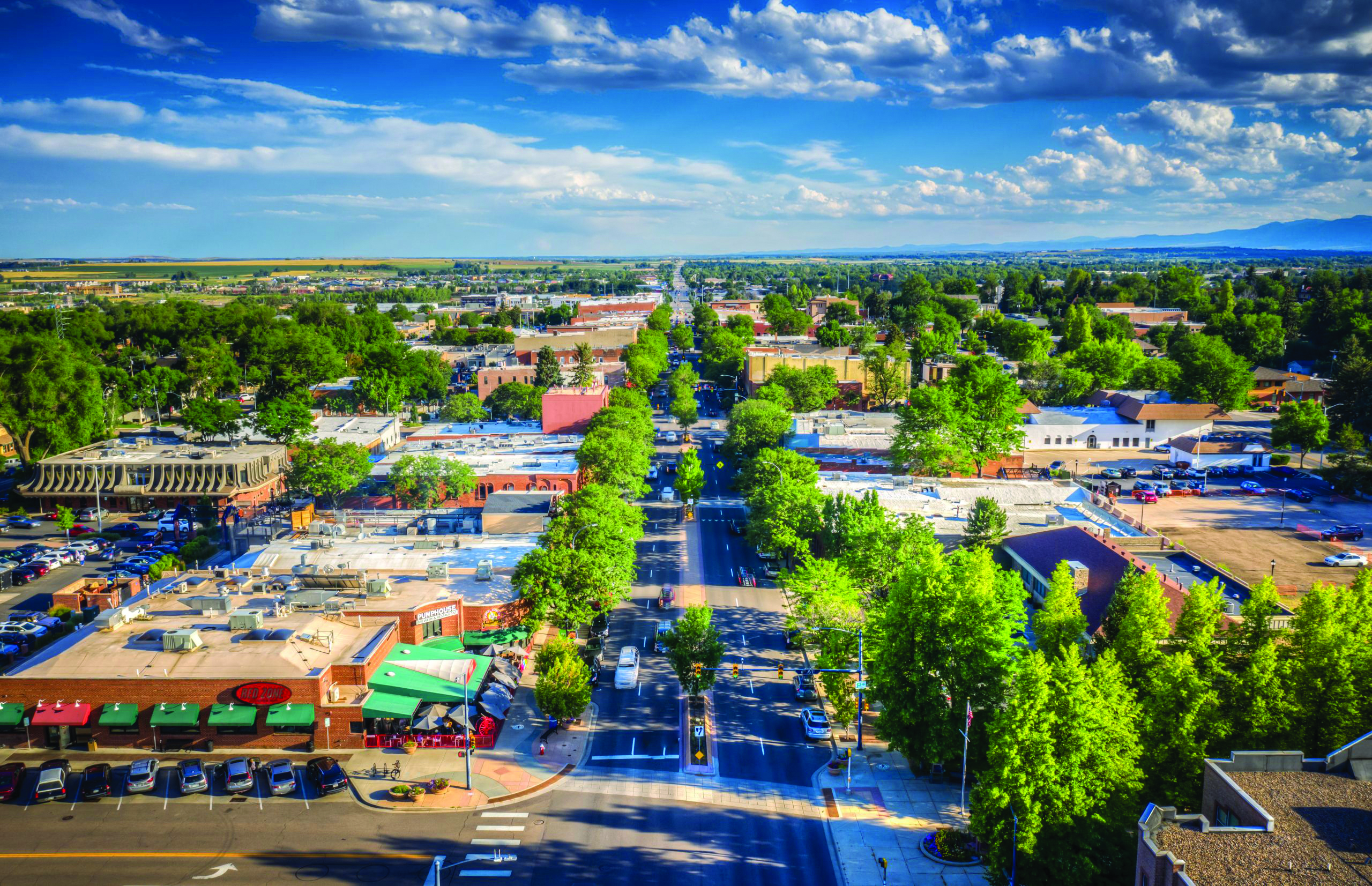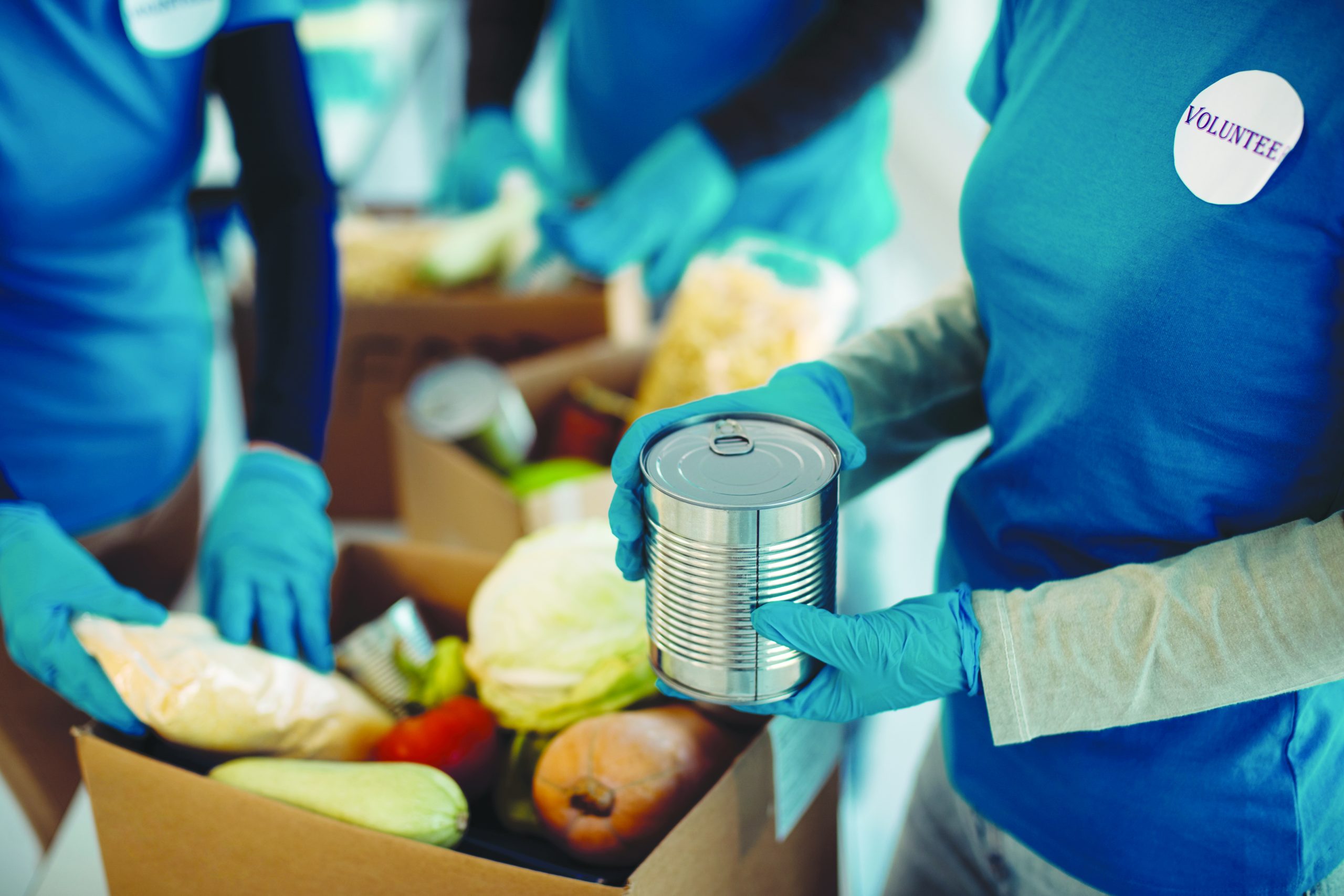
Walking into Community Food Share’s distribution facility in Louisville, the receptionist makes sure everyone is standing six feet apart, directing them toward an automatic hand sanitizer dispenser. She’s wearing blue disposable gloves, and speaking loudly so that everyone, spread out, can hear. Volunteers take turns signing in on an iPad, after they sanitize of course. Large barrels sit just inside the double doors, which are open, even with snow in the forecast. It’s the new system of dropping off food donations — minimizing interaction of staff, volunteers and donors, ensuring people are touching as few surfaces as possible.
“It’s an adjustment for volunteers and participants,” says volunteer Carol Achatz of Boulder. She’s helped out at the Louisville facility about three times a week for the past eight years, with no sign of slowing down, coronavirus aside. “I’m really impressed by the way this organization has adapted.”
Before the onset of the COVID-19 pandemic, 40,000 community members relied on the Community Food Share network, a group of 40 nonprofits throughout Boulder and Broomfield counties. But in the first three weeks of March, participation at its Louisville and mobile pantry programs increased by 37% compared to the same time frame in 2019. Wednesday, March 18 was record-breaking for the Louisville facility, as 411 families came through to get food. That’s double the number served on a typical day pre-pandemic, says Julia McGee, director of communications.
At food banks and distribution programs across Boulder County there has been a significant increase of people in need, as unemployment claims have skyrocketed around the state and thousands of businesses have shuttered. At the same time, these feeding organizations have seen a decrease in food donations from grocery stores and other partners, as well as a delay in food deliveries.
But that’s not stopping them. They’re in it for the long haul.
As McGee says, “The recovery in our community, we know, is going to last much longer than the virus itself.”

Distribution issues
Nearly 90% of the food Community Food Share hands out comes from grocery stores. But, in recent weeks there has been a disruption in that food supply, as stores have scrambled to keep their shelves stocked in the midst of panic-buying by many consumers.
In March, Community Food Share saw a 23% decrease in food donations from grocery stores compared to February. On a week-by-week basis, it may dip as much as 30% or 40%, McGee says.
“We’ve seen a decline of primarily meat, dairy and dry goods, which again, makes sense if you’re personally going to the grocery store and you’re seeing which shelves are empty,” she says.
Hayden Dansky, executive director of Boulder Food Rescue (BFR), says some restaurants have given one-time donations as they close, but BFR has also seen a decline in grocery store donations as that’s where it gets the majority of its food, too.
“It’s not a consistent decline, it’s up and down and all over. We sort of suspect it might be sporadic for a while,” Danksy says. “[But] we are still receiving donations from all of our grocery store partners.”
The supply chain is starting to balance itself out, says Will Sorenson, store director at Alfalfa’s Market in Boulder, which gives to BFR and Community Food Share. “The first couple weeks of this people were panicking and overbuying and there just wasn’t the labor for distributors to supply us with what we needed.”
Alfalfa’s may have ordered 10 cases of a certain product, but only one would be delivered. And then, “The second we would put it on the shelf it was gone,” he says.
Alfalfa’s also closed its culinary service, meaning day-old meals from the prepared food counter are no longer going to food banks either. All of this left very little for the store to donate to its partner food programs.
At the same time, nonprofits have been purchasing more and more food to meet increasing community need, despite weeks-long delivery schedules. Community Food Share, which purchases about 5% of its food normally, bought 166,000 pounds of food in March versus 68,000 pounds in February.
“The problem is that there’s alarming delays in the delivery time,” McGee says. “So we’re hearing from them that we are going to have to wait anywhere from four to eight weeks depending on the vendor.”
Julie Van Domelen, executive director of Emergency Family Assistance Association (EFAA) in Boulder says delivery dates and how much of its order EFAA will actually get are often unclear. “I’ve been told it’s not a food supply issue, it’s really more a distribution, trucking, delivery issue,” she says.
Truckers around the country have been working overtime to deliver supplies but have also been confronted with myriad issues arising from the coronavirus shutdowns. Not only is their health and safety a concern, but many rest stops and truck stops across the country have been closed by state and transportation authorities’ orders, only to be reopened again after pushback from the American Trucking Associations.
“We’re in a constant state of calibration and so the quantities that we can provide might change week by week to both our partner agencies as well as in our programs,” McGee says. “It’s all going to depend on when the food arrives.”
Despite all this, Community Food Share gave all of its partner agencies 20% more food at the beginning of the month, and remains confident it will continue to have enough food to pass out to whoever needs it.
Changing the process
As a way of affirming people’s dignity despite their circumstances, most food distribution programs around Boulder County typically present food to clients in a way that allows them to “shop” for themselves. But concern over the quick and easy spread of COVID-19 makes this model impossible now. Instead, clients are given pre-boxed or bagged items at food banks and distribution programs. Many of the organizations have changed and/or reduced their hours in order to further separate people and avoid spreading the disease.
“We’ve completely revamped how our food bank operates,” Van Domelen says. “Unfortunately, people don’t have much choice but they have safety.”
Curbside pickup isn’t feasible at EFAA, but at Community Food Share and other places, parking lots have been turned into drive-thru services, with orange cones set out to direct traffic.
“We also had to reroute food,” Dansky says. Normally, BFR has 28 different grocery program sites within the community. But 10 of those were at child-care centers and schools, which are now closed. (Community Food Share is partnering with BVSD to provide food for families on Tuesday and Thursdays.) BFR’s current 18 grocery program sites are done in partnership with Boulder Housing Partners and Thistle to bring groceries into the low-income and affordable housing complexes, serving seniors, families and individuals who have a hard time accessing food. BFR’s clients face multiple barriers such as irregular working hours, living with disabilities or having to rely on public transportation.
“Especially right now, if people don’t have their own cars, the bus systems are especially a high-risk place to be and a lot of those folks are at higher risk for the coronavirus,” Danksy says.
BFR doesn’t require any sort of paperwork or proof of eligibility for residents to access its groceries, and Community Food Share is currently waiving all documentation and eligibility requirements for its food program. Other food pantries are still asking for some personal information such as date of birth, address or identification.
Volunteers needed… Sometimes
Historically, all of these nonprofits have relied heavily on volunteers. But that’s changing for a lot of places as well.
EFAA has suspended its volunteer program and now boxes are packed in the morning by volunteers from Team Rubicon, a group of Iraq and Afghanistan veterans trained in disaster response. Afternoon pickup is staffed by a regular group of temporary paid staff.
“We’ve zipped up the building,” Van Domelen says. “We just looked at the numbers and we just think this is the safer way of working.”
Other organizations are still using volunteers, under specific circumstances. Although most relied on volunteers over the age of 65 previous to the coronavirus outbreak, those populations are now being asked to stay home.
As long as people aren’t sick or have reasonable suspicion that they’ve been exposed, they’re welcome at BFR, Danksy says. “We’ve been clearly communicating the risk and letting people make their own decisions,” she says.
Over the last few weeks, the nonprofit has virtually trained 45 new volunteers to help with food pick-up and delivery to grocery sites. But BFR suspended its bike delivery program, and is asking more of its grocery program managers, volunteers who typically live within the community they serve, as they are now in charge of bagging and boxing all food to distribute.
“Communities take care of each other, they are going to look out for each other, and people are willing to take on the extra labor of bagging food and making sure it’s all sanitized and to make sure their community is safe,” Danksy says.
At Community Food Share, volunteer support is dropping. Large groups began cancelling shifts at the beginning of March, even before “social distancing began in earnest,” McGee says, who, like other staff, has been stepping in to help.

In the first three weeks of March, the Food Share saw a 32% drop in volunteers, including a 26% decrease in donated hours. A limited number of individual volunteers are still needed, however, and everyone practices social distancing, wears gloves and sanitizes regularly.
“We need more volunteers in order to continue doing our work,” she says. “Yet we also have to limit the amount of people who are coming into our buildings so that we can maintain all of the recommendations that are coming from the CDC.”
Needed items
Even if folks are unable to volunteer, food banks are still accepting food donations, with a specific need for staples like peanut butter, tuna, canned fruits and vegetables, and other proteins, Van Domelen says. McGee adds rice and pasta to the list.
But according to most food banks, the real need right now is for monetary donations and industry/corporate sponsors, which allow the organizations to purchase the products they know their clients need the most.
Community Food Share encourages people to give to its rapid response fund, which goes toward its purchasing budget. Plus, due to its partnerships with producers and wholesalers, $1 donated provides $5 worth of groceries.
“We want to make sure that we always have certain staples in stock at our warehouse, regardless of coronavirus,” McGee says. “We need to make sure that we have the things that people really need to get by.”
Preparing for the future
Only one of the Food Share’s community partners — at Front Range Community College Longmont — has closed due to the pandemic, according to McGee.
But that doesn’t mean things won’t change in the coming days, weeks and months. According to Sorenson at Alfalfa’s, although the shelves are now stocked, product is moving through the store faster, as more people are cooking from home. Plus, some items recently stocked have a year of shelf-life or more.
“So that will affect what we’ll be able to donate,” he says.
Plus, Colorado hasn’t yet hit the height of the pandemic according to public health officials, and Boulder County’s food pantries are constantly adapting to the evolving situation.
“We’re expected to be challenged a bit more on food distribution models,” Van Domelen says. BFR is planning for the future as well, innovating different ways to meet the needs of the community, whether that’s possibly sourcing food from local farms or hiring more temporary contract workers.
“We’re planning into the future to address things as they change,” Danksy says, “as far into the future as one can plan right now.”
HERE’S WHERE TO GIVE
Boulder County is the state’s fourth most generous county, according to an analysis of IRS tax returns done by SmartAsset, a personal finance company. When it comes to the number of households that give, as well as the percentage of net income they donate, Boulder County residents are beyond generous.
In that spirit of giving, here is a (partial) list of food programs currently in need of donations. Please check individual websites for specific donation requests.
• Boulder Food Rescue, boulderfoodrescue.org/give-support-during-covid-19
• Community Food Share, Rapid Response COVID-19 Fund, serving Broomfield and Boulder counties, main location in Louisville, communityfoodshare.org/coronavirus
• Emergency Family Assistance Association (EFAA), Boulder, efaa.org/get-involved/donate
• OUR Center Longmont, ourcenter.org/donate-items
• Harvest of Hope food pantry, Boulder, hopepantry.org/donate
• Lyons Community Food Pantry, leaflyons.org/food-pantry.html
• Nederland Food Pantry, nederlandfoodpantry.org/wish-list/
• Sister Carmen Community Center, Lafayette, sistercarmen.org/community-notice
• The Community Foundation Boulder County has also set up a COVID-19 Response Fund — commfound.org — that has secured $738,425 as of March 24, which is funding a number of these organizations and more.



